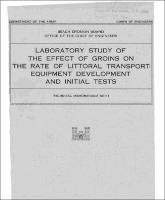Please use this identifier to cite or link to this item:
https://hdl.handle.net/11681/3413| Title: | Laboratory study of the effect of groins on the rate of littoral transport : equipment development and initial tests |
| Authors: | United States. Army. Office of the Chief of Engineers Savage, Rudolph P. |
| Keywords: | Groins Littoral transport Littoral processes Sand movement Lab equipment |
| Publisher: | United States, Beach Erosion Board Engineer Research and Development Center (U.S.) |
| Series/Report no.: | Technical memorandum (United States. Beach Erosion Board) ; no. 114. |
| Description: | Technical Memorandum From the Introduction: Groins (structures extending into the water - usually perpendicular to the shore line) are frequently used to widen or stabilize beaches. It is known that, under certain conditions, groins trap and hold littoral material, thus building or retaining a beach. This means that, at least during the initial portion of the life of a groin or groin system, the littoral transport rate is reduced along the portion of the shore on which the groin or groin system is installed. There are, however, no data on how the littoral drift in the vicinity of the groins varies with time after the installation of the groins, and only meager data on the effect of the groins on the long term rate of littoral transport. Rates of littoral transport were estimated for the northern New Jersey coast for the period from 1885 to 1951. (1) These data indicate that the littoral drift rate for the 18-year period from 1933 to 1951 was approximately 12 percent less than the rate for the previous 48 year period (1885 to 1933). This reduction in the drift rate was ascribed, at least in part, to the numerous groins constructed along that portion of the shore during the period 1933 to 1951. Other factors, such as a difference in weather patterns, could possibly have produced this observed reduction in the littoral drift rate, but the possibility that the groins caused the drift rate reduction is exceedingly interesting and is deemed important enough to justify further study. Therefore, a laboratory study is being made of the effect of groins on some aspects of the littoral processes. These are: the effect of a groin system on the rate of littoral transport past the system; the stabilization of the beach within the groin system; and the erosion downdrift from the groin system. Interpretation of the movable-bed model studies is difficult since small-scale studies such as the one to be discussed here cannot be scaled directly to give exact quantitative values for use under prototype conditions. It is believed, however, that the results from this study will be valuable in giving qualitative insight into the littoral processes in the vicinity of a groin system and some comparative information on the rate of transport past a groin system. |
| Rights: | Approved for public release; distribution is unlimited. |
| URI: | http://hdl.handle.net/11681/3413 |
| Appears in Collections: | Technical Memorandum |
Files in This Item:
| File | Description | Size | Format | |
|---|---|---|---|---|
| BEB-TM-114.pdf | 4.09 MB | Adobe PDF |  View/Open |